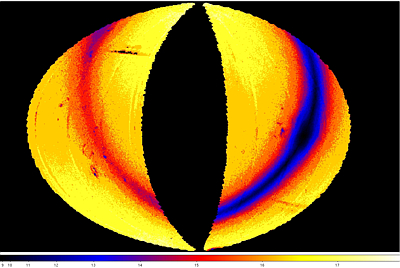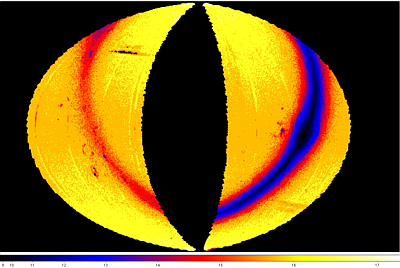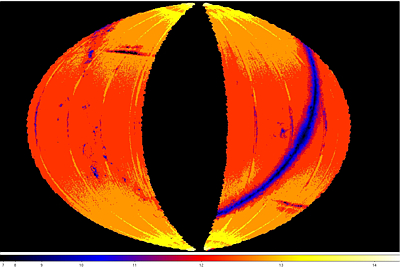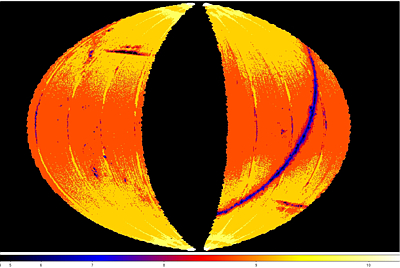I. Introduction
4. Cautionary Notes
b. Source Catalog
Contents
- Source Detection
- Position Reconstruction
- Source Photometry
- Photometric Uncertainties
- Photometrical Calibration and Color-Corrections
- Unreliable Sources
- Very Bright Sources
- Artifact Flagging
- Extended Sources
- 2MASS Associations
i. Source Detection
- The Depth the Preliminary Release Source Catalog Varies With Position on the Sky
The limiting magnitude of the objects in the Preliminary Release Source
Catalog is regulated by the net exposure time accumulated by WISE and
characteristics of the sky where source extraction
takes place. Among the factors that dictate the
achieved limiting depth are:
- Effective depth-of-coverage (VI.2), including
survey coverage, data quality and frame and pixel outlier rejection,
- Background emission levels and structure (Zodiacal emission,
diffuse and complex Galactic emission),
- Confusion noise in high source density regions, and
- Effective sky masking by very bright sources (i.e. scattered
light halos, diffraction spikes, latent images, ghosts and glints)
and extended saturated regions (e.g. the Galactic Center, Orion).
The bulk variation in depth of the Source Catalog around the sky
is illustrated in Figures 1-4 that show maps of the peak of the Catalog
source count histograms in each band. The impact on the effective depth
of the Catalog by survey depth-of-coverage is manifested as the
increasing depth from the ecliptic plane towards the poles. The loss of
depth due to confusion in the Galactic Plane is most prominent in W1 and W2
where the source density is highest.
 |
 |
| Figure 1 - W1 |
Figure 2 - W2 |
 |
 |
| Figure 3 - W3 |
Figure 4 - W4 |
| False-color maps showing the spatial distribution and
variation of the peak of the differential source count histograms computed in
0.2x0.2 deg spatial bins. The color scale in the images gives
the peak magnitude color encoding for each band. The
Maps are Hammer projections in ecliptic coordinates.
The centers correspond to ecliptic coordinate 180°,0°.
Ecliptic north is towards the top, and ecliptic longitude increases
towards the right. |
- The Preliminary Release Source Catalog Has A Conservative Detection Threshold
To emphasize reliability of the Preliminary Release Catalog, a
conservative source detection threshold was used during
first-pass Multiframe processing.
Sources were required to have SNR>5 on the multiband sigma images
(IV.5.b for detection and characterization
to construct the Working Database (WDB) of extractions.
Furthermore, a WDB entry was required to have a SNR>7 in at least
one detected band to be included in the Catalog, as described in
V.3.b.
You will very likely be able to see faint sources on
Atlas Images that do not have counterparts in the Preliminary Release
Source Catalog as a result.
- Suppressed Detections of Sources Around Very Bright Stars
Very bright sources effectively mask the sky in their vicinity.
Detections of fainter sources are suppressed because the local background levels
are elevated from the scattered light halos, and because of
confusion with diffractions spikes, latent images, and optical
ghost images from the bright sources. Furthermore, even when
fainter sources are detected near very bright objects, they may
be flagged as contaminated and inadvertently filtered from the
Catalog. The impact of masking by bright sources is
discussed in VI.2.c.ii.
- Extended Sources Split Into Multiple Components
As discussed below, Sources that are significantly
larger than the WISE beam may be artificially split into multiple
extractions. Hence, very large galaxies and complex nebulosity in the
Galactic Plane may produce clusters of entries in the Source Catalog.
- Sources Lost Due to Confusion in the Duplicate Resolution Processing
The duplicate source resolution process
in Source Catalog generation
identified duplicate detections in the Tile overlaps regions and
selected one for inclusion in the Source Catalog using simple
geometric criteria. The selected duplicate apparitions were then
required to satisfy the final source selection
criteria to be included in the Catalog. In a small number of cases,
one member of a group of multiple detections may have been
selected by the duplicate resolution test but did not satisfy the
final source selection criteria whereas the apparition that was not
selected by duplicate resolution would have met the final criteria.
1,923 objects are known to have been omitted from the Catalog
because of this confusion.
ii. Position Reconstruction
- Systematic Declination Errors
The positions of objects in the WISE Preliminary
Release Source Catalog may be systematically offset from their
try position by up to 1" in the declination direction.
Approximately 20% of sources fainter than W1~14.5 mag exhibit this
bias, while an increasingly smaller fraction of the sources are
biased up to at least W1=13.0 mag. The declination bias was caused by
an error in the pipeline source extraction software that failed to apply
a 0.5 Atlas Image pixel declination offset to some sources when performing
simultaneous PSF fitting of multiple
detections in close proximity (i.e. passive deblending).
The sign of the declination bias depends on the scan direction and
celestial hemisphere in which a source is location.
The error does not affect right ascension measurements.
See VI.5 for illustrations of the effects
of this error and discussion of its impact.
The quoted position declination uncertainties in the Catalog,
sigdec, have been inflated to reflect
the presence of the bias. See the following section for a description.
Reliable positions may be extracted by measuring source positions
on the Atlas Images. However, positions derived using
flux-weighted centroid or peak finding and the WCS information in the
Atlas Image headers is also biased relative to the Source Catalog
by up to 0.5" in W1-W3 and up to 1.4" in W4. See
II.3.g for a procedure to correct
the Atlas Image derived source positions and image WCS.
- Catalog Declination Uncertainties Have Been Inflated to Reflect
the Declination Bias
Because there was insufficient time to correct the
declination bias prior to the
Preliminary Release, the Catalog declination uncertainties,
sigdec, were inflated to
reflect the presence of the bias.
The uncertainties were
adjusted by adding 0.5" in quadrature to the statistical
declination measurement uncertainty
(see VI.5.b). This yields a maximum
absolute deviation for the distribution of uncertainties equal to the
what would be produced if the declination error distribution was Gaussian.
Users who conduct studies based on the Preliminary Release Catalog
positions should note that the distribution of true position residuals
with respect to the 2MASS reference frame is not Gaussian, and will
not scale as they would for a Gaussian
(see VI.5.b).
- Differential Aberration not Corrected in First-Pass Processing
Correction for differential aberration was not made during the
first-pass processing. This can
contributes a small (~0.1") increase in the observed positions residuals
with respect to the 2MASS reference frame that correlates with position
on the sky because it is related to the WISE relative orbital velocity.
Correction for differential aberration will be included in
second-pass processing.
iii. Source Photometry
- Catalog Photometry is Optimized for Point Sources
For point-like objects, the profile-fit photometry measurements
(w?mpro) provide the most accurate measurements for
unresolved (to WISE) objects.
The curve-of-growth corrected "standard-aperture" photometry can on
average provide slightly better accuracy for sources with approximately
SNR>30 because they not subject to PSF knowledge uncertainties like the
profile-fit measurements. However, aperture measurements are more
susceptible to contamination from aberrant and masked pixels within
the measurement aperture.
The profile-fit and standard aperture photometry will systematically
underestimate the brightness of objects that are extended with respect
to the WISE
PSF. See below for further discussion of
extended objects.
- A non-null entry in the WISE Source Catalog magnitude column
for a given band does not necessarily mean a detection in that band.
If the associated measurement uncertainty in band is "null", then the
quoted magnitude is computed from a 2σ brightness upper limit
(see IV.5.c.iii.3).
Care must be taken to not mis-interpret upper limits as detections.
- Systematic Brightness Underestimation In Very High Source Density
Regions
As discussed in VI.4.c, WISE source
brightnesses are systematically underestimated in very high
source density regions. This occurs because background levels in
those regions are overestimated by contamination from surrounding stars.
Improved background estimation algorithms have been employed for
WISE second-pass processing.
- Aperture Photometry Limitations
The Preliminary Release Source Catalog contains aperture photometry
measurements made on the Atlas Images for apertures ranging in
size from 5.5" to 24.75" (W1-W3) and 11.0" to 49.5" (W4).
These measurements have not been curve-of-growth corrected like
the standard-aperture magnitudes.
The large-aperture photometry is useful for estimating the brightness
of small, extended sources too large to be properly measured
using the profile-fit and standard-aperture photometry.
Users should be aware of features and limitations of the
aperture measurements.
- The standard-aperture photometry
in the Source Catalog has been curve-of-growth corrected.
- The W4 apertures for a given group of magnitudes are always a factor
of two larger than the W1, W2 and W3 apertures
- Aperture photometry is subject to contamination by missing, masked or
aberrant pixels in the measurement aperture, confusion with nearby
objects and saturation. Use the aperture photometry measurement quality flags,
w?flg,
w?flg_1,
w?flg_2, to assess
if one or more pixels in the measurement aperture was contaminated.
- Aperture photometry will systematically underestimate the
brightness of saturated sources.
- As described in VI.4.c, aperture
photometry for sources fainter than 13 mag (W1 and W2) becomes systematically
brighter than the profile-fit photometry because of confusion with faint
sources within the measurement aperture. This impacts primarily W1 and W2
because source densities are much higher on average.
- Erroneous Flux Measurements for Sources in Low or No-Coverage Regions
Sources that are extracted near regions with very low or no
depth-of-coverage sometimes exhibit
erroneous flux measurements because the background estimate has been
compromised by the low coverage. In these cases, the background
estimates can be aberrantly low, resulting in an apparent bright
source where one does not exist. Many of these sources are suppressed by
the minimum depth of coverage requirement for Catalog source
selection (VI.3.b), but sources
affected by this on one band may be pulled into the Catalog if they
have better coverage in other bands.
Refer to the w?m and
w?cov parameters in the
Catalog to identify bands that may affected by low coverage.
- Active Deblending Will Split Sources Into At Most Two Components
WISE profile-fitting photometry attempts
to deblend a detection into two components if the single-PSF fit
chi-squared goodness-of-fit value is >1.8. If the resulting
two-component fit reduces the chi-squared from the initial
one, and the two-component chi-squared is <3 (from
an initial value >3), the two sources are reported.
For first-pass processing,
at most one component can be added. Actively deblended sources in the
Preliminary Release Source Catalog can be identified by having the parameter
na=1.
Note that active deblending was not performed in the profile-fitting
measurements for the Single-exposures.
iv. Photometric Uncertainties
- Several Different Measurements Of Photometric Uncertainty Are
Provided in the Source Catalog
WISE Source Catalog entries contain several different measurements
of photometric uncertainties.
- w?sigmpro - These are the
profile-fit photometry measurement uncertainties in magnitude units.
Similarly, w?msigm are the formal
aperture photometry measurement uncertainties. Note that the
magnitude uncertainties are null when the sources
are not detected.
- w?snr - These are the ratios
of the flux (in DN) to the flux uncertainty from the profile-fit photometry
measurements. The profile-fit magnitude uncertainties are derived
from these values if the SNR is >2. The SNR values are
populated even for SNR<2 measurements.
- w?sigp1 and w?sigp2 - These are the standard deviation of the population and
standard deviation of the mean of the fluxes measured on the individual
frames used for the profile-fitting photometry, respectively.
The former provides a measure of the characteristic measure of the
scatter in the single-exposure measurements.
These are useful as diagnostics with which to compare to the
formal profile-fit measurement uncertainties, which come from
PSF-fitting on all exposures simultaneously, but should not be used
as a substitute for them.
- Profile-fit Photometry Uncertainties Are Overestimated in High Source Density Regions (leads to
systematically low chi-squared values)
The profile-fit photometry measurement uncertainties, w?sigmpro are systematically underestimated in high
source density regions because the contribution of confusion noise
was overestimated. Consequently, the profile-fitting chi-squared values,
w?rchi2, are systematically underestimated
in these regions which can have adversely affect decisions to
deblend confused sources in crowded fields.
- Profile-fit Measurement SNR Values (w?snr) Typically Do Not Exceed
40-60
The profile-fit photometry flux SNR values in the
WISE Source Catalog, w?snr, do not usually
exceed ~60 even for extremely bright sources. This occurs because the
profile-fit measurement includes a PSF uncertainty component that dominates
the measurement precision at high SNR levels. As a result, profile-fit
measurement signal-to-noise ratios do not continue to increase
arbitrarily with source brightness.
v. Photometric Calibration and Color Corrections
- Photometry Presented in Natural WISE System
All Catalog source magnitudes represent in-band brightness
measurements that are calibrated by comparison
with WISE measurements of a network of standard stars of presumably known
brightness within the WISE bands (see IV.3.g).
The magnitudes are not monochromatic values.
- Zero Point Stability and Calibration Accuracy
The WISE system photometric response was stable to
<<1% over the life of the cryogenic survey
(IV.3.g.vii).
Therefore, single photometric instrumental zero points in each band
are used to calibrate photometry.
For first-pass processing, these zero points were defined
using the first two months of on-orbit data.
Residuals biases with respect to the mean brightness of the standard
stars is <0.01 magnitudes in W1, W2 and W4 in the Source Catalog.
For W3, a there is a mean bias of approximately 0.022 magnitudes in
the sense that the Catalog W3 magnitudes may be on average
0.022 mags fainter than their quoted values (e.g. add 0.022 mag
to the Catalog W3 mags to get a better calibrated measurement).
- Color-Corrections
The broad WISE bandpasses may necessitate significant color corrections
when deriving monochromatic flux densities from the in-band
magnitudes depending on the spectral energy distribution of
the particular object. The nominal system flux zero points are defined
for a fν∝ν-2 spectrum
through the WISE bandpasses.
Color corrections for other spectral slopes are given
in IV.3.g.vi and
Jarrett et al. (2011 in press).
vi. The WISE Preliminary Release Source Catalog Contains Unreliable Entries
The reliability of Source Catalog is estimated to by >99.9%
for sources brighter than W1<15.6, W2<14.3, W3<10.2, W4<6.5 mag
in unconfused regions of the sky with 12 or more frame coverages
(VI.7).
The fractional reliability decreases for fainter objects and
in regions where there is less coverage. Therefore, for a catalog
the size of the WISE Source Catalog, there will be thousands of unreliable
entries that do not correspond to an actual object on the sky.
The source selection criteria used to construct the Source Catalog
were designed designed to construct a reliable
Catalog from the superset of extractions in the Working Database.
Exploit the WISE survey strategy of obtaining multiple, independent
exposures of each region of the sky, conservative detection limits,
flagging of artifacts in processing pipeline.
Here are some tips for selecting preferentially reliable
entries in the WISE Preliminary Release Source Catalog.
- Select sources detected in more than one band.
On average, sources detected in only one of the four WISE bands will be
less reliable on average than those detected in multiple bands.
This is not to imply that all single-band sources in the Catalog
are unreliable. In fact, some of the most interesting objects
are anticipated to be detected in only one band (e.g. brown dwarfs,
highly embedded protostars, extreme ultraluminous galaxies), but
they are statistically rare in the Catalog, constituting
only 4.4% of the total. Use care when working with single-band sources.
-
Select sources with a depth-of-coverage >5.
Frame and pixel outlier rejection during the image coaddition processing is most efficient where the
survey depth-of-coverage is highest.
Effectively no outlier rejection was
performed with depth <5 during image coaddition in Multiframe processing.
Sources in lower coverage regions have a higher probability of
being spurious detections of transient single-frame artifacts.
- Select sources with higher signal-to-noise ratios. - Sources
with higher profile-fit photometry SNR values,
w?snr, in one or more bands will
be more reliable than those with very low SNR values. This is really
an SNR limitation, not a flux threshold. An extraction with
bright apparent flux, but with low SNR is just as likely to be
unreliable.
- Select sources that are not flagged as spurious detections of
image artifacts in any band. The
cc_flags Catalog column identifies
sources that were positionally associated with the predicted position
of artifacts from bright sources. The Catalog
source selection criteria require that
a source not be flagged as a spurious detection of an artifact in at least
one band (along with meeting other reliability criteria in that band).
However, Catalog sources may be flagged as spurious detections
in other bands, making it suspicious.
To exclude such objects, select sources where
cc_flags not matches '*[DHOP]*').
vii. Artifact Identification
- Limitations to Artifact Flagging in the Preliminary Release
Source extractions that are positionally associated with the predicted
locations of image artifacts produced by bright sources were
identified and flagged in the Artifact Identification
subsystem of the WSDS Multiframe Pipeline.
Artifact locations are predicted using geometric models scaled with
"parent" bright source magnitudes. These models and their parameters
were based on analyses of IOC and approximately one month of survey data,
so could not be fully optimized in the time necessary to begin
first-pass processing.
As a consequence, artifact identification and flagging in the
Source Catalog is both overly conservative in some areas, and
deficient in others.
- Most Artifacts from Off-Frame Sources Not Flagged
With the exception of latent images, no attempt was made
in first-pass processing to flag
artifacts from sources detected on a given Atlas Image that were
produced by bright sources outside the footprint of that Tile.
This includes diffraction spikes, scattered light halos and optical ghost
images. Therefore, contaminated sources and spurious detections
from off-image sources may be unflagged in the Source Catalog.
- Overly Conservative In First-Pass Processing
To emphasize the reliability of the Preliminary Release Source Catalog,
the artifact flagging model parameters of artifacts were conservatively set
in the sense that sources tended to be overflagged.
This results in decreased Catalog completeness around bright stars
(see VI.2.c.iii,
and a large percentage of all sources being flagged as contaminated
in very high source density regions.
- Missed Flagging Due to Inaccurate Bright Star Photometry or Detection
Source brighter than approximately 1.0, 0.0, -2.0 and -6.0 in
W1, W2, W3 and W4, respectively, were not reliably extracted in
first-pass processing (VI.4.d.iv).
Therefore, artifacts produced by these objects will not be flagged in
the Source Catalog. For example, the star Aldebaran is in the
Preliminary Release Catalog, but it has valid photometry
only in W4 (-2.90 mag). It was not properly extracted in W1, W2 and W3,
and therefore artifacts and spurious detections from Aldebaran's
artifacts in those bands will be in the Source Catalog without appropriate
artifact flagging.
viii. Very Bright Sources
- Sources brighter than approximately 1.0, 0.0, -2.0 and -6.0 in
W1, W2, W3 and W4, respectively, may not be in the Source Catalog
Source brighter then these limits were not reliably extracted in
first-pass processing (VI.4.d.iv). If they
are brighter in all bands, they may not be appear
in the Source Catalog. Such objects may be in the Source Catalog if
they were properly extracted in a fainter band. However, photometry will
likely will be missing or badly inaccurate in the very bright bands.
- Saturated Source Photometric Biases
Saturation begins to affect sources brighter than
approximately 8.0, 6.7, 3.8 and -0.4 in W1, W2, W3 and W4.
Profile-fit photometric measurements
are extracted for saturated sources by fitting the PSF to the non-saturated
pixels in their wings. Sources brighter than the saturation limit
exhibit varying degrees of photometric bias, as described
in VI.4.c.i. The most severe bias
is seen in W2 where source brightness may be overestimated by
nearly one magnitude approximately two magnitudes brighter
than the saturation limit.
As discussed above, missing detections
of bright stars can lead to the failure to flag spurious and contaminated
to detections that may wind up in the Catalog.
ix. Extended Sources
- The WISE Source Catalog contains both Point and Resolved Source
WISE does not have a separate extended source catalog. The WISE Source
Catalog contains entries for all sources detected on the Atlas Images, both
point-like and small resolved objects.
- Profile-fit and Standard Aperture Photometry Underestimate the Brightness
of Resolved Sources
The Profile-fit and standard aperture photometry in the Source
Catalog are optimized for point-source characterization. They both
systematically underestimate the brightness of extended sources
(IV.5.c.vi). Refer to the
ext_flg to identify
Source Catalog entries that may be extended.
Large aperture photometry is provided for Catalog entries, and
those measurement may provide better estimates for extended objects.
For WISE sources that are associated with objects in the
2MASS Extended Source Catalog (XSC), measurements in
elliptical apertures scaled from
the object size and shape in the 2MASS XSC are provided
in the WISE Catalog that better characterize the object flux.
- Large Extended Objects May Be Broken Into Multiple Detections
in the Source Catalog
The source detection and extraction steps in the WISE pipelines
may split large, extended objects into multiple pieces. Any and all
pieces that that satisfy the source selection criteria will appear
in the Catalog. See IV.5.c.vi
for examples that illustrated extended source splitting.
Refer to the
xscprox column to find WISE Catalog
entries that may be sections of large galaxies identified by the
2MASS XSC. However, WISE is sensitive to large Galactic diffuse emission
structures, and these objects will also be split into multiple components
that will not be tracked by the
xscprox column.
x. 2MASS PSC Associations
The WISE Source Catalog entries include photometry for
the closest entry from the 2MASS Point Source Catalog that falls within
3" of the WISE source positions (IV.7).
These are associations not identifications.
Although the position accuracy of the two Catalogs is very good,
there is a non-zero probability of chance associations between
physically unrelated objects, as well as missed associations between
the Catalogs. This is particularly true for objects with high proper
motions, and those in regions with large foreground extinction.
You should always confirm associations by reviewing carefully the
entries from both Catalogs.
Last update: 2011 May 4
Previous page Next page
Return to Explanatory Supplement TOC



